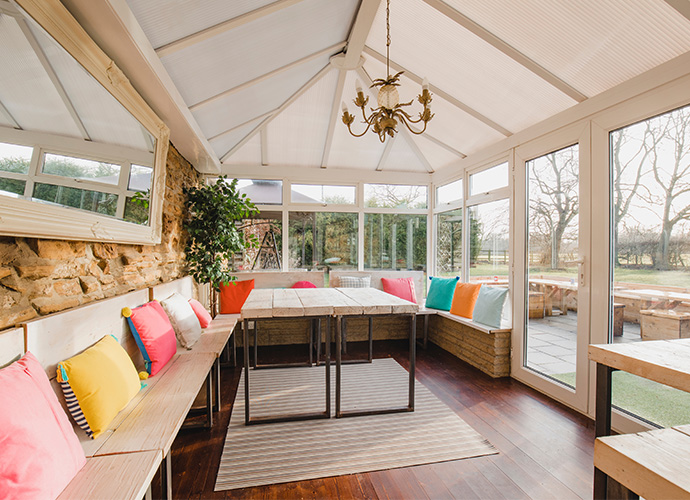Conservatories are a popular addition to homes across the UK, offering a space to relax and enjoy natural light all year round. However, during the colder months, conservatories can become less inviting due to poor insulation. In this article, we’ll explore various methods to insulate and heat your conservatory, transforming it into a cosy space to enjoy even in winter.

Understanding Conservatory Insulation
Before diving into insulation techniques, it’s important to understand why conservatories often lose heat. The main culprits are usually the glass or polycarbonate roof and the large windows. While they’re excellent for letting in sunlight, they’re not always the best for retaining heat.
Roof Insulation
Insulating the roof of your conservatory is a key step in retaining heat. You can opt for internal insulation, which involves installing a false ceiling or using insulated plasterboard. This method is cost-effective and doesn’t significantly alter the external appearance of your conservatory. However, it does reduce the amount of natural light entering the space.
Another option is external roof insulation. This involves applying insulation material on top of the existing roof, which is then covered with a waterproof layer. This method is more expensive but retains the conservatory’s original height and natural light.
Window Insulation
Windows are another significant area of heat loss. Double glazing is a standard solution, offering an extra layer of insulation compared to single-glazed windows. If you already have double glazing, check the seals and draught-proofing around the windows and doors, as these can wear out over time.
Thermal blinds or curtains can also add a layer of insulation while giving you the flexibility to let in light during the day.
Floor Insulation
Often overlooked, the floor can be a source of heat loss, especially if it’s not properly insulated. Insulating the floor may involve lifting the existing flooring and adding an insulating material, like a high-quality foam board, before relaying the floor. This can be a more invasive process, so it’s important to weigh the benefits against the disruption and cost.
Heating Solutions
Apart from insulation, choosing the right heating solution is crucial for a warm and inviting conservatory.
Radiators
If your central heating system has the capacity, extending it to include radiators in your conservatory is an efficient way to keep it warm. Ensure that the radiators are properly sized for the space.
Underfloor Heating
Underfloor heating is an excellent option for conservatories. It distributes heat evenly across the floor, making it comfortable to walk on and ensuring there are no cold spots in the room.
Electric Heaters
For a quick and less invasive solution, electric heaters can be effective. However, they might not be the most cost-effective method for prolonged use.
Considerations for Heating
When choosing a heating system, consider the insulation level of your conservatory. Highly insulated conservatories require less heating, which can save you money in the long run. Also, think about how you use the space – if you only use it occasionally, a portable heater might be sufficient.
Enhancing Energy Efficiency
One of the simplest yet effective ways to improve your conservatory’s insulation is by draught-proofing. Check for any gaps around windows, doors, and where the conservatory joins the main house. Using draught excluders and weather strips can make a significant difference.
Reflective Insulation
Reflective insulation materials, like multi-foil, can be installed under the roof panels. These materials reflect heat back into the conservatory, reducing heat loss in winter and helping keep the space cooler in summer.
Smart Heating Solutions
Installing a smart thermostat in your conservatory allows for more precise temperature control. You can set schedules or control the heating remotely, ensuring the space is warm when you need it without wasting energy.
Solar Heating
Utilising the conservatory’s natural affinity for sunlight, solar heating panels can be a sustainable option. These panels can be used to heat the space directly or to contribute to your home’s heating system.
Maintenance and Care
To ensure the longevity and effectiveness of your conservatory’s insulation, regular maintenance is key. This includes cleaning the roof and gutters, checking for any leaks or damage, and ensuring that insulation materials remain in good condition.
Professional Assessments
Having a professional assess your conservatory can provide insights into the best insulation and heating options for your specific situation. They can identify areas of heat loss and recommend tailored solutions.
Insulating and heating your conservatory can transform it into a comfortable, inviting space all year round. While some solutions may require a significant upfront investment, the benefits of a warm, usable space can be well worth the cost.





